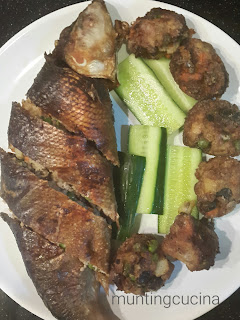I love this sponge cake recipe. It is made with eggs, sugar and flour. No leavening needed, the eggs are whipped to create the foam so the cake would rise naturally. The flour has to be sifted two to three times so no lumps would be present and it will be easier to be dissolved and will blend well into the egg mixture. I actually powderize the sugar to make sure it will melt properly and easily. I find this to be easier than the chiffon cake. Sometimes the meringue flops and the cake doesn't rise. This sponge cake is definitely a no fail cake. Easy to follow instructions using the exact measurement to make it a success. Some sponge cake recipes require no butter, I just added the butter because it will taste better. It is completely up to you, if you're not a fan of butter then just omit it from the recipe. Your sponge cake will still be beautiful and will rise as it should. This cake is similar to pound cake and chiffon cake, the process of making them makes it different from each other. For the chiffon the eggs are separated and the whites are beaten to make the meringue, for the pound cake you beat the batter altogether and the cake becomes tight and heavy. I'm comfortable with this recipe, for sure I will always use this often than the chiffon.
The egg white is responsible for making baked goods rise. They act as leavening agent when whipped as they trap and hold air. The proteins in egg white help the rising process of a cake such as a chiffon, angel cake and sponge cake. The albumin creates small bubbles when whipped and the increase in volume thus holds water as well. The ovalbumin helps to curdle during baking helps the cake take shape as the water evaporates.
Ingredients:
6 eggs
1 1/2 cups flour
1 cup white granulated sugar
1/4 cup butter
2 tablespoons milk
1/4 teaspoon salt
Method:
- Preheat oven to 300 degrees at least for 15 minutes before placing cake. Line 8 inches cake pan.
- Sift flour twice then set aside, melt the butter and add milk.
- Place your eggs and sugar in the bowl of the stand mixer then whisk and melt sugar over a pot of simmering water on low heat until egg mixture becomes lukewarm.
- Whip the eggs until thick and fluffy. Fold the flour in 3 parts then add the butter and milk fold once again until all is incorporated.
- Place batter into prepared cake pan and bake for 25 to 30 minutes until toothpick is dry when inserted. Enjoy this beautiful and easy step by step recipe.












